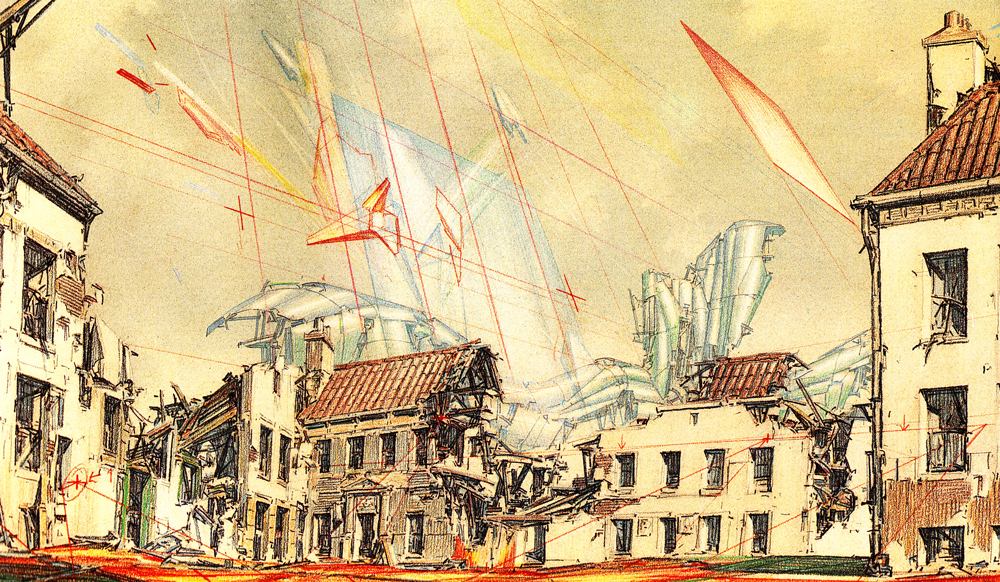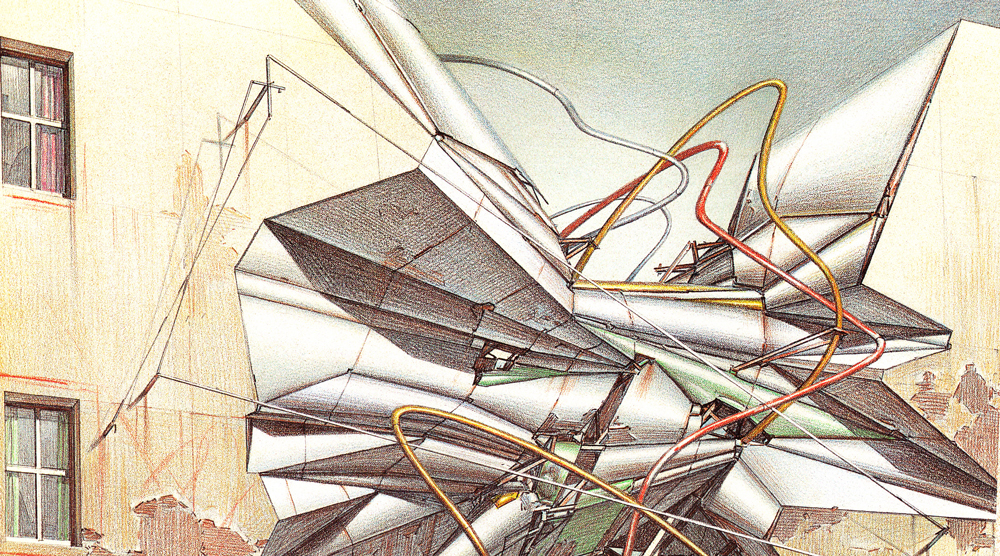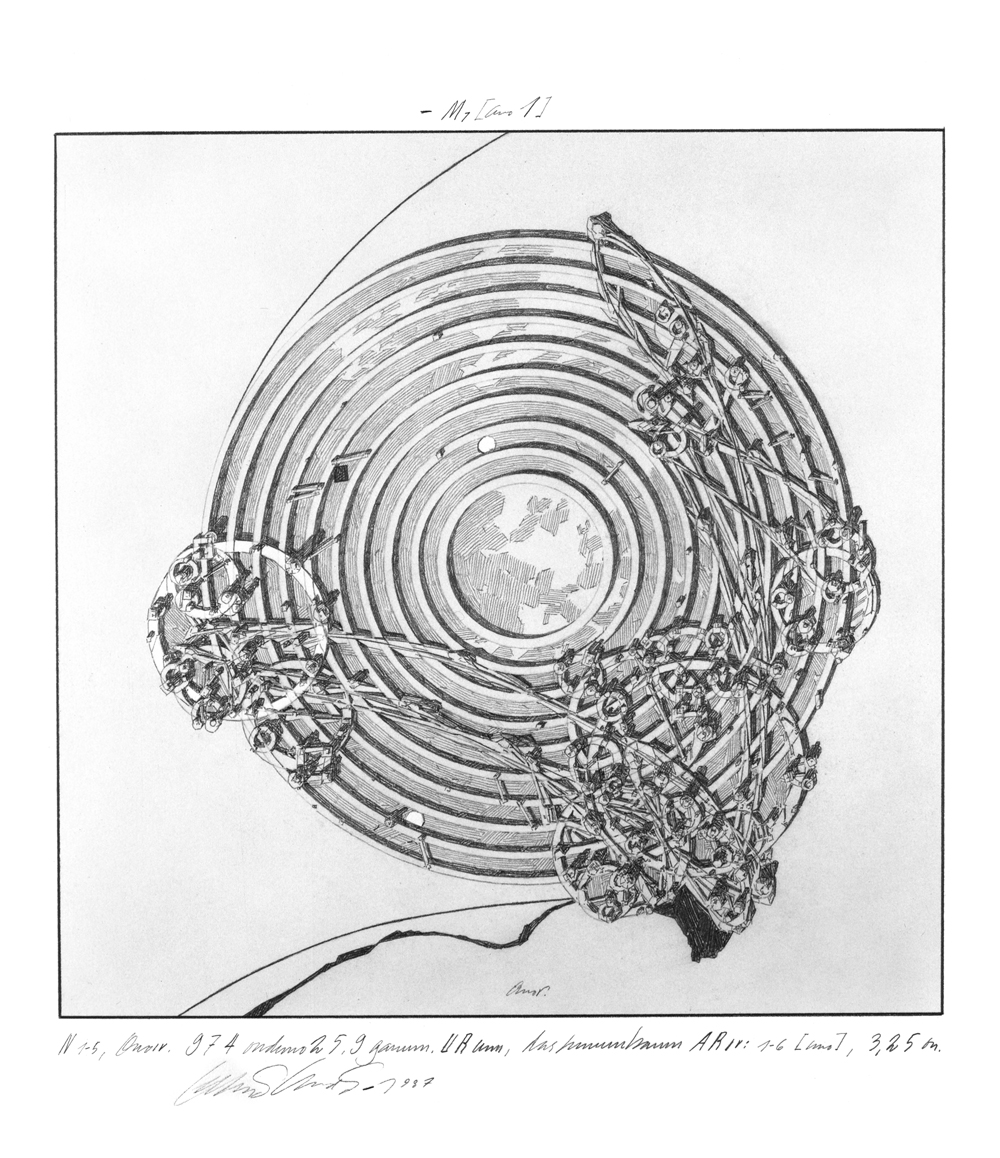Joshua Johnson

Lebbus Woods, Projects for the reconstruction of Sarajevo, 1993–1996
Architecture and war are not incompatible.
Architecture is war. War is architecture.
I am at war with my time, with history, with all authority that resides in fixed and frightened forms. —Lebbeus Woods1
When Lebbeus Woods speaks of war, he also speaks of time. If history is trauma, then the future is catastrophe. Caught between the positivism of modernist progress and a reactionary postmodern uncertainty, Woods attempted to build a new future atop the lacerated and pulsing topography of the battleground. He embraced, on the one hand, the epistemic skepticism of postmodernism, while, on the other, never abandoning the Promethean impulse of modernism towards the future.
The Drawing Center is the current host to “Lebbeus Woods, Architect,” a traveling retrospective (curated by Joseph Becker, Jennifer Dunlop Fletcher, Helen Hilton, and organized by the San Francisco Museum of Modern Art) which is loosely organized according to a chronological trajectory and covers about 30 years of Woods’s work. Various drawings—configured around a grid of vitrines containing maquettes, sketchbooks, and other materials—are hung sequentially with interspersing quotes taken from Woods’s writing printed on the walls. The exhibition offers a fairly staid and dryly academic presentation, following a conventionally Cartesian plan that does not quite capture the truly radical format of his work or its import for the present day. Nonetheless, the panoramic overview of his practice, process, and thought provides plenty of fuel for those who look beyond the rote survey presentation. Woods, who passed away in 2012, left an enduring legacy that continues to hold sway over our collective vision of the future. For Woods, the future was something to be constructed. He distanced himself from the label “Deconstructivism” (the postmodern architectural movement aligned with the literary and philosophical theory of “deconstruction”) and its manipulation and dislocation of the surface effects of architecture. His work was often associated with Deconstructivism, but Woods was more properly a constructivist.
The earliest work in the exhibition, The Einstein Tomb (1980), displays Woods’s interest in a scientifically led architecture, as well as his speculative vision. A tribute to Albert Einstein—who requested that no monuments be erected after his death that could become the site of pilgrimage—The Einstein Tomb is a hulking Brutalist cross. The tomb is adorned on two opposing ends of the cross with city-like spires and pierced in its hollow center by a beam of light, along which it travels out from Earth to the edges of the universe.
The desolate cities of this monolith were to inspire an extended interest in Einstein’s concept of relativity and its disruption of the stable universe of Newtonian mechanics. The development of scientific knowledge became a principle in Centricity (1986–88) and its companion works, Aeon (1981) and A-City (1986), Woods’s ambitious project to conceive entire utopian cities. Presented with Woods’s usual expert draughtsmanship, Centricity revels in monumental forms and seemingly impossible architectures, appearing like mechanical medieval termite mounds. Contrary to much of the architectural thought of his day, Woods conceptualized this city, not upon theories of history or culture, but around the geometries of mathematics and scientific development: “Science changes the very idea of what is natural and human, of what human capacity and strength really are.”2

Scientific and technological progresses are another form of the paradoxical and shifting territory that Woods thought architecture must embrace to become fully human. The Copernican revolution, for instance, displaced and diminished man’s historic role in the cosmic story which he had assigned himself. Woods used the word “paradoxical” often to point to the complexities of a future in which comfortable human certainties are challenged beyond their historical conception. He labeled this an “existential” challenge, for which the figure of war was to stand for the catastrophic changes and crises that could not be named with existing forms of knowledge. However, he did not see the destruction of the past as a call to retreat and buttress old conceptions. Rather, it was as an opportunity to remake the image of man, precisely upon the site where the wound was inflicted. This theme is explored continuously throughout the War and Architecture Series, which includes Underground Berlin (1988), Aerial Paris (1989), Berlin Free-Zone (1991), Zagreb Free-Zone (1991), and the projects for the reconstruction of Sarajevo (1993–96).
In Underground Berlin (1988), he envisions an architecture that might heal the ideological divides of East and West Berlin through a literal ungrounding of the city. While in Berlin Free-Zone (1991), Woods proposes a hidden architecture tunneling through the city’s monuments of authority to create “freespaces” connected by modern communications technology. Freespaces are Woods’s conception of an autonomous space meant to foster a new adaptation to everyday living. Injected into the existing architecture, the use of freespaces was radically underdetermined by design and without any pre-set plan for habitation. Though not pre-planned in purpose, freespaces were formally experimental—eschewing the linear and grid-like composition of the surrounding architecture—to catalyze a way of living that was disconnected from the forms of the old world. In Berlin Free-Zone freespaces act as arteries in a vast cybernetic system transposed upon the existing order, collecting pockets of resistance and transforming them into a multi-cellular cybernetic organism united to a new purpose.
Woods explicitly characterized his approach to architecture as that of a second-order cybernetic system. Cybernetics is a purposive science, concerned with the goal-oriented behavior of systems. Second-order cybernetics attempts to grapple with the complex feedback loops that occur between a model and the system which envelops it. For instance, while an engineer may have a detailed view of the specific materials and functions that inform the construction of a bridge, her model of that bridge is constrained and only minimally considers the broader system within which it is enveloped, such as the surrounding landscape, further infrastructure, traffic, etc., and limits those feedback loops according to fixed tolerances. While the engineer may mistake the model for the system, second-order cybernetics emphasizes the distinction and recognizes it as a representation, attempting to understand how observation of the system and the complex epistemological issues that this raises feed back into the system.
Woods never loses sight of the complex feedback loops between the sociocultural and infrastructural issues erupting in the space of war. With High Houses and Sarajevo (1993) he offers the hopeful reconstruction of a city tragically torn asunder by war. Rather than raze and rebuild, he suggests the organic solution of intervening in the scarred architecture, inserting “ideology-free spaces” amidst the broken fragments of the former Yugoslavia. While these spaces, envisioned by a scabrous, piecemeal architecture, are seemingly purposeless, they were meant to be engaged as new modes of living; distinctly configured from the habitual structures of everyday life, they form concrete pockets of revolutionary experience within the shattered remnants of the old order.
In his book Radical Reconstruction, Woods mentions two principles of drawing: “Draw architecture as though it were already built” and “Build architecture as though it had never been drawn.”3 With these two statements, he indexes the distinction between the abstract model and the concrete realities of the system, and brings them into dialogue with one another. “Drawing it as if it had been built” enables the abstract conception of a new way of living that may be concretely realized, while “building as if it had never been drawn” allows for the spontaneous practice of freedom in response to concrete problems. In Kant’s transcendental framework, freedom derives from the ability to conceive the self-conscious unity of what “ought” to be rather than what “is” in the concrete empirical sense. Freespaces not only exemplify the practice of freedom in the concept of their construction, but, moreover, offer a new communal space from within which to develop that concept. For Woods, it was the spontaneous construction of the community’s vision of what “ought” to be, in dialogue with the radical autonomy of space, which would open architecture into new ways of living.
With architecture, Woods saw a way to represent the building of a new reality that was not dependent upon the historical, cultural, and ethnic divisions that plagued Yugoslavia’s formation after World War II. While particular and complex architectural problems derive from historical situations, we are free to develop the function of our architecture in a manner that is not in keeping with the causes of that historical trauma. From a cybernetic perspective, Woods saw architecture as offering the possibility of rehabilitating the functions of a system that had lost equilibrium, but it was only through an understanding of the complexities of that system that we could hope to achieve this. His works are not meant to erase the conflict in which they intervene, but to propose an emancipatory practice beyond the limits of that conflict.
In San Francisco: Inhabiting the Quake (1995), rather than buttressing the failed principles of an architecture which props up the city amidst the fault lines of ever-shifting tectonic plates, Woods proposes a form of architecture that slides and reconfigures along with the tremors. From economic crisis, ecological disaster, growing inequality, and any number of other pressures, we now live in a state constantly threatened by collapse. Perhaps we need new approaches, like those suggested by Woods: We need a practice that does not shy away from the catastrophe which postmodernism found amongst the torn bedrock of modernism’s foundations, but embraces its best impulses; a practice that builds not against the ruin, but with it; a practice that rekindles the embers of enlightenment and freedom in the ashes. From the war-torn streets of Sarajevo to a fantastic monument cast to the edges of the universe on a beam of light, Woods shone a beacon upon these foundations of the future.

Endnotes
1. Lebbeus Woods, War and Architecture (New York: Princeton Architectural Press, 1993).↩
2. Lebbeus Woods, “Centricity,” Places, Vol. 5, No. 3 (Summer 1988), accessed: http://places. designobserver.com/media/pdf/Centricity_181. Pdf.↩
3. Lebbeus Woods, Radical Reconstruction (New York: Princeton Architectural Press, 1997).↩












